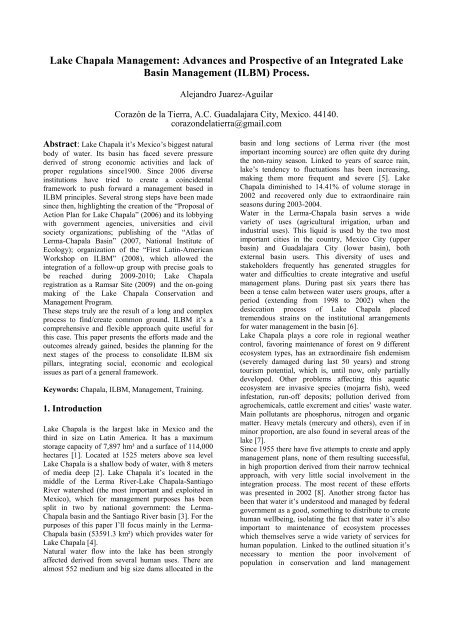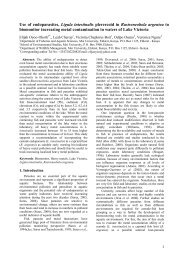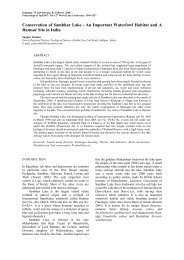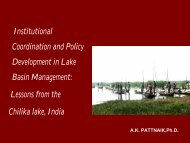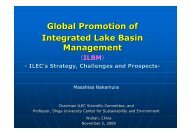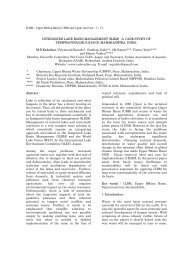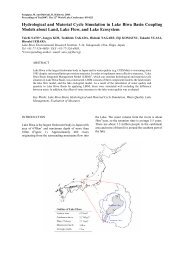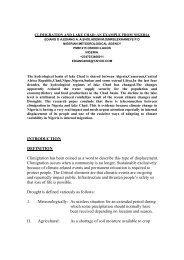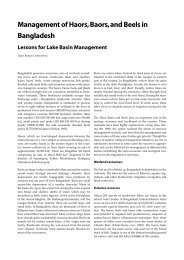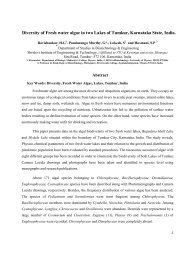Lake Chapala Management - World Lake Database
Lake Chapala Management - World Lake Database
Lake Chapala Management - World Lake Database
Create successful ePaper yourself
Turn your PDF publications into a flip-book with our unique Google optimized e-Paper software.
<strong>Lake</strong> <strong>Chapala</strong> <strong>Management</strong>: Advances and Prospective of an Integrated <strong>Lake</strong><br />
Basin <strong>Management</strong> (ILBM) Process.<br />
Alejandro Juarez-Aguilar<br />
Corazón de la Tierra, A.C. Guadalajara City, Mexico. 44140.<br />
corazondelatierra@gmail.com<br />
Abstract: <strong>Lake</strong> <strong>Chapala</strong> it’s Mexico’s biggest natural<br />
body of water. Its basin has faced severe pressure<br />
derived of strong economic activities and lack of<br />
proper regulations since1900. Since 2006 diverse<br />
institutions have tried to create a coincidental<br />
framework to push forward a management based in<br />
ILBM principles. Several strong steps have been made<br />
since then, highlighting the creation of the “Proposal of<br />
Action Plan for <strong>Lake</strong> <strong>Chapala</strong>” (2006) and its lobbying<br />
with government agencies, universities and civil<br />
society organizations; publishing of the “Atlas of<br />
Lerma-<strong>Chapala</strong> Basin” (2007, National Institute of<br />
Ecology); organization of the “First Latin-American<br />
Workshop on ILBM” (2008), which allowed the<br />
integration of a follow-up group with precise goals to<br />
be reached during 2009-2010; <strong>Lake</strong> <strong>Chapala</strong><br />
registration as a Ramsar Site (2009) and the on-going<br />
making of the <strong>Lake</strong> <strong>Chapala</strong> Conservation and<br />
<strong>Management</strong> Program.<br />
These steps truly are the result of a long and complex<br />
process to find/create common ground. ILBM it’s a<br />
comprehensive and flexible approach quite useful for<br />
this case. This paper presents the efforts made and the<br />
outcomes already gained, besides the planning for the<br />
next stages of the process to consolidate ILBM six<br />
pillars, integrating social, economic and ecological<br />
issues as part of a general framework.<br />
Keywords: <strong>Chapala</strong>, ILBM, <strong>Management</strong>, Training.<br />
1. Introduction<br />
<strong>Lake</strong> <strong>Chapala</strong> is the largest lake in Mexico and the<br />
third in size on Latin America. It has a maximum<br />
storage capacity of 7,897 hm³ and a surface of 114,000<br />
hectares [1]. Located at 1525 meters above sea level<br />
<strong>Lake</strong> <strong>Chapala</strong> is a shallow body of water, with 8 meters<br />
of media deep [2]. <strong>Lake</strong> <strong>Chapala</strong> it’s located in the<br />
middle of the Lerma River-<strong>Lake</strong> <strong>Chapala</strong>-Santiago<br />
River watershed (the most important and exploited in<br />
Mexico), which for management purposes has been<br />
split in two by national government: the Lerma-<br />
<strong>Chapala</strong> basin and the Santiago River basin [3]. For the<br />
purposes of this paper I’ll focus mainly in the Lerma-<br />
<strong>Chapala</strong> basin (53591.3 km²) which provides water for<br />
<strong>Lake</strong> <strong>Chapala</strong> [4].<br />
Natural water flow into the lake has been strongly<br />
affected derived from several human uses. There are<br />
almost 552 medium and big size dams allocated in the<br />
basin and long sections of Lerma river (the most<br />
important incoming source) are often quite dry during<br />
the non-rainy season. Linked to years of scarce rain,<br />
lake’s tendency to fluctuations has been increasing,<br />
making them more frequent and severe [5]. <strong>Lake</strong><br />
<strong>Chapala</strong> diminished to 14.41% of volume storage in<br />
2002 and recovered only due to extraordinaire rain<br />
seasons during 2003-2004.<br />
Water in the Lerma-<strong>Chapala</strong> basin serves a wide<br />
variety of uses (agricultural irrigation, urban and<br />
industrial uses). This liquid is used by the two most<br />
important cities in the country, Mexico City (upper<br />
basin) and Guadalajara City (lower basin), both<br />
external basin users. This diversity of uses and<br />
stakeholders frequently has generated struggles for<br />
water and difficulties to create integrative and useful<br />
management plans. During past six years there has<br />
been a tense calm between water users groups, after a<br />
period (extending from 1998 to 2002) when the<br />
desiccation process of <strong>Lake</strong> <strong>Chapala</strong> placed<br />
tremendous strains on the institutional arrangements<br />
for water management in the basin [6].<br />
<strong>Lake</strong> <strong>Chapala</strong> plays a core role in regional weather<br />
control, favoring maintenance of forest on 9 different<br />
ecosystem types, has an extraordinaire fish endemism<br />
(severely damaged during last 50 years) and strong<br />
tourism potential, which is, until now, only partially<br />
developed. Other problems affecting this aquatic<br />
ecosystem are invasive species (mojarra fish), weed<br />
infestation, run-off deposits; pollution derived from<br />
agrochemicals, cattle excrement and cities’ waste water.<br />
Main pollutants are phosphorus, nitrogen and organic<br />
matter. Heavy metals (mercury and others), even if in<br />
minor proportion, are also found in several areas of the<br />
lake [7].<br />
Since 1955 there have five attempts to create and apply<br />
management plans, none of them resulting successful,<br />
in high proportion derived from their narrow technical<br />
approach, with very little social involvement in the<br />
integration process. The most recent of these efforts<br />
was presented in 2002 [8]. Another strong factor has<br />
been that water it’s understood and managed by federal<br />
government as a good, something to distribute to create<br />
human wellbeing, isolating the fact that water it’s also<br />
important to maintenance of ecosystem processes<br />
which themselves serve a wide variety of services for<br />
human population. Linked to the outlined situation it’s<br />
necessary to mention the poor involvement of<br />
population in conservation and land management
issues [9]. Generally speaking there is a lack of public<br />
access to information and just few cases of<br />
organizative development linked to improvement of<br />
social, productive and ecological processes.<br />
It’s relevant mention that Lerma-<strong>Chapala</strong> basin shows<br />
depletion of underground water (1 to 5 meters, varying<br />
depending of the particular aquifer) and that most<br />
frequent struggles have happened between irrigation<br />
farmers and Guadalajara City users. This situation<br />
increases dramatically when lake <strong>Chapala</strong> reduces its<br />
volume derived of scarce rain and water retention in<br />
the upper and middle basin.<br />
Federal government created the Lerma-<strong>Chapala</strong> Basin<br />
Council back in 1989 as a mechanism to reach<br />
agreements and solve problems related to basin’s water<br />
use, but despite several advances in that issue this<br />
space has been perceived (and frequently used) as a<br />
political arena, often ignoring matters of water<br />
recharge linked to territorial use (basin management).<br />
Also due to conflictive points of view of participants<br />
(representatives of urban, industrials and agricultural<br />
uses, besides five state governments), the federal<br />
government usually has used a very cautious approach<br />
that generated slow changes. The Basin Council<br />
emphasizes the role of water users and water agencies,<br />
usually ignoring links between rivers with <strong>Lake</strong><br />
<strong>Chapala</strong>, forest management, crop planning and urban<br />
development issues related to water recharge, quality<br />
and volume. Also receiving small consideration are the<br />
paper of researchers, universities, environmental<br />
agencies and civil society organizations, which rarely<br />
gained access to the council and only as speakers.<br />
2. The Integrated <strong>Lake</strong> Basin <strong>Management</strong><br />
(ILBM) in Lerma <strong>Chapala</strong> basin.<br />
2.1 ILBM Structure and origins<br />
ILBM is a conceptual framework for assisting lake<br />
managers and stakeholders in achieving sustainable<br />
management of lakes and their basins. It takes into<br />
account the biophysical features as well as managerial<br />
requirements for lake basin systems, that are<br />
associated with the lentic water properties of lakes as<br />
well as the inherent dynamics between humans and<br />
nature in the process of development, use and<br />
conservation of lake and basin resources [10]. It was<br />
developed as result of a Global Environment Facility<br />
(GEF) project conducted by the International <strong>Lake</strong><br />
Environment Committee Foundation (ILEC), a<br />
scientific group based in Japan, which analyzed and<br />
summarized the experiences of 28 lake basins around<br />
the world [11]. The experiences learned from the GEF-<br />
ILBM project indicate that good lake basin<br />
management requires: a) Institutions to manage the<br />
lake and its basin for the benefit of all lake basin<br />
resources uses, b) Policies to govern people’s use of<br />
lake resources and their impact on lakes, c)<br />
Involvement of people, central to lake basin<br />
management, d) Technological possibilities and<br />
limitation that exist in almost all cases, e) Knowledge,<br />
both of a traditional and scientific nature is valuable,<br />
and f) Sustainable finances to fund from all of the<br />
above activities. These constitute the essential six<br />
pillars of basin governance about which ILBM can<br />
provide the overall framework for application.<br />
2.2 Applying ILBM in the Lerma-<strong>Chapala</strong> basin:<br />
first steps.<br />
Despite the importance of ILBM as a powerful tool for<br />
lake basin management it was scarcely known in<br />
Mexico and Latin America. Understanding its value to<br />
foster the Lerma-<strong>Chapala</strong> basin management and to<br />
overcome the frequent basin users’ quarrels, Corazon<br />
de la Tierra, a Mexican Civil Society Organization<br />
(CSO) invited ILEC to take part in an Expert<br />
Workshop and Open Forum named “<strong>World</strong> <strong>Lake</strong><br />
Vision: constructing an Action Plan for <strong>Lake</strong> <strong>Chapala</strong><br />
Basin”, held from November 1 st to 4 th , 2006. As result<br />
of the intense three days work of 18 participants (12<br />
Mexican and 6 foreigners, each one an expert in their<br />
own field) a proposal of Action Plan for the Lerma-<br />
<strong>Chapala</strong> Basin was created, which was then presented<br />
to a wide group of stakeholder representatives (117<br />
participants coming from the five states of the basin,<br />
including municipal, state and federal government<br />
levels; universities, civil organizations, farmers, etc.)<br />
This diverse set of people received the information,<br />
analyzed and complemented it, finally generating 135<br />
lines of action integrated in six Strategies: Optimal use<br />
of water; Prevention and control of water pollution;<br />
Biodiversity management; Social involvement for<br />
basin management; Monitoring of lake and its basin;<br />
and Sustainable management models. The fact that a<br />
proposal of this kind could be so widely structured,<br />
based in sound scientific information and experience<br />
from the expert participants and then backed up by the<br />
wide range of attendants was unprecedented. The<br />
document was checked and edited, comprising lines of<br />
action to 117 to publicly present the document in<br />
March 22 nd 2007, as part of the <strong>World</strong> Water Day [12].<br />
Unfortunately 2006-2007 was a period of deep<br />
administrative changes in federal, states and municipal<br />
government levels, immediately after political elections.<br />
So, most of 2007 and half 2008 were used for lobbying<br />
the Action Plan document with new officers, to let<br />
them know its thematic contents and to convince them<br />
about its importance. A common perception was that<br />
the Action Plan was (quoting a federal officer) “too<br />
inclusive and extensive” meaning that no institution<br />
could accomplish to aboard it completely and that<br />
several stakeholders were needed to work together to<br />
reach shared goals. As a result a frequent reaction was<br />
to decline participation because that represented high<br />
effort and (apparently) little political gain.<br />
Nevertheless several allies were found in the process,<br />
highlighting involvement of Jalisco’s state government
through the Secretary of Environment and Sustainable<br />
Development (SEMADES); and the National Institute<br />
of Ecology (INE, a federal agency), whose Integrated<br />
Basin <strong>Management</strong>’s head officer took part in<br />
constructing the Action Plan.<br />
2.2 Developing guidelines<br />
Given the hard path found to foster the Action Plan,<br />
several inner meetings were organized and as result we<br />
concluded that several conditions could help to push<br />
forward it, being these: a) to distribute specific lines of<br />
action among particular actors, to be reached more<br />
easily; b) to promote the Action Plan at the<br />
international level, which would help to get national<br />
support for it; c) to use a sub-basin approach, to<br />
involve regional stakeholders and make feasible to<br />
reach outcomes in a shorter term; d) to create a<br />
common ground with government agencies to broaden<br />
visions and cement long-term processes.<br />
Using such guidelines Corazon de la Tierra included as<br />
part of its institutional programs action lines related to<br />
ecological sanitation, forest management and<br />
environmental education, with reachable goals in short<br />
and medium terms. In order to do that, resources from<br />
federal and state agencies were obtained and channeled<br />
to local communities, mainly through the Sustainable<br />
<strong>Management</strong> Program of Condiro-Canales Mountain<br />
Range [13], a forest area within the basin, in process to<br />
become a natural protected area. Activities included<br />
forest restoration, making of an ecotourism<br />
management plan [14], construction of wood-saving<br />
stoves [15] and dry-latrines in rural villages [16],<br />
inclusion of several tropical deciduous-forest lands in<br />
the “ecological services payment” federal-programs,<br />
forest management training provided to land owners,<br />
installment of community tree nurseries, environmental<br />
education projects with school children and youth,<br />
among others lines of action included in the Action<br />
Plan.<br />
As part of the international promotion the Action Plan<br />
workshop experience and its derived follow-up<br />
activities were presented in the XII <strong>World</strong> <strong>Lake</strong><br />
Conference [17] held in Jaipur, India in November<br />
2007, being distinguished with the Ibaraki-<br />
Kasumigaura Prize for “its outstanding content”. The<br />
case was also presented in the First <strong>Management</strong> of<br />
Arid and Semi-arid Basin Forum, held in Argentina the<br />
same year [18]. In July 2008 the experience was<br />
presented at the international workshop “Sustainability<br />
of <strong>Lake</strong> Remediation and Interventions” organized by<br />
the Japanese International Cooperation Agency (JICA)<br />
and the Hyderabad Urban Development Authority,<br />
which was held in Hyderabad, India. All these<br />
activities were publicized in Mexico, alongside with<br />
presenting in Guadalajara City of the book “<strong>World</strong><br />
<strong>Lake</strong> Vision Action Report” [19] which includes a<br />
chapter related to <strong>Lake</strong> <strong>Chapala</strong>. These activities<br />
allowed to create regional and national interest for the<br />
issue, fostering the perception of the Action Plan<br />
importance and feasibility.<br />
2.3 The Sub-basins approach<br />
About promoting this approach, during 2007-2008<br />
there were several meetings with INE’s Integrated<br />
Basin <strong>Management</strong> Office. This research institution<br />
leads the federal agencies working in the Lerma-<br />
<strong>Chapala</strong> basin and has strong coincidence about<br />
importance of the sub-basin management. There are 19<br />
sub-basins in the Lerma-<strong>Chapala</strong> basin and INE<br />
selected five of them as priority, using as criteria the<br />
existence of working groups in each one. Also, INE<br />
and the National Autonomous University of Mexico<br />
(UNAM) developed and presented in 2007 the “Atlas<br />
de la Cuenca Lerma <strong>Chapala</strong>” (Atlas of Lerma-<strong>Chapala</strong><br />
Basin), an integrative book that presents in a precise<br />
and useful way a wide amount of high quality scientific<br />
information.<br />
To raise the sub-basin involvement INE organized a<br />
sharing-experience workshop during June 25-26 th 2009,<br />
which allowed direct contact of 50 participants from<br />
the five priority sub-basins, in an attempt to compare<br />
processes, identify useful patterns, common challenges<br />
and strategies [20]. As part of the workshop the ILBM<br />
approach was presented, awakening a lot of interest<br />
particularly because of its practical focus. Use of this<br />
instrument by the whole five sub-basins groups (about<br />
75 institutions including municipalities, federal and<br />
state agencies; CSOs, universities, research centers and<br />
even private companies) will be structured in a followup<br />
meeting scheduled for December 2009.<br />
2.4 The Latin American ILBM Workshop<br />
Creation of a common ground with government<br />
agencies (mainly federal and state level), research<br />
centers and other civil society organizations was<br />
defined as a crucial matter in order to increase direct<br />
involvement in joint projects to achieve integrated<br />
management of Lerma-<strong>Chapala</strong> basin. This was<br />
probably the most difficult task, given the distrust<br />
generated during past years between many stakeholders.<br />
In fact, assuming the facilitator role as a civil society<br />
organization represented both vantages and<br />
disadvantages, giving us freedom to act without<br />
political or administrative constraints and the ability to<br />
move quickly or slowly according to circumstances,<br />
but also making difficult to be heard by certain sectors<br />
given the hard clashes generated in the 1998-2003<br />
period. It was necessary to develop a preciseagreement,<br />
long-term approach with several<br />
institutions so that step by step strong relationships<br />
could be constructed. As part of this “common ground<br />
construction” it was clear that ILBM training was<br />
necessary to raise the knowledge level and to foster<br />
strong stakeholder links. A workshop was selected as a<br />
practical tool, attractive for many institutions which
identified it as an opportunity to learn about this<br />
approach and, simultaneously, present their own<br />
findings and activities. The ILBM workshop was<br />
directed to Latin America countries in order to have<br />
bigger impact and to count with higher diversity of<br />
experiences.<br />
The workshop idea was initially presented to<br />
SEMADES to count with a strong local actor<br />
supporting it. SEMADES showed immediate interest to<br />
back-up the idea, which was presented to ILEC<br />
members during the XII <strong>World</strong> <strong>Lake</strong> Conference held<br />
in India (October 29th to November 2 nd , 2007). Next<br />
three months (December 2007-February 2008) were<br />
used to define concrete times and contents of the<br />
workshop, also to integrate two more Mexican<br />
institutions, the Water Commission of Jalisco State<br />
(CEA) and the Instituto Tecnologico de Estudios<br />
Superiores de Occidente (ITESO, Technological<br />
Institute of Higher Studies of Western Mexico), the last<br />
one providing the academic backing-up to validate<br />
academic credits.<br />
A useful way to assure reaching of workshop goals was<br />
to create commitment from the involved Mexican<br />
institutions to registry part of their staff as participants,<br />
counting with four seats for each organization. Also,<br />
each one promoted the workshop call with their own<br />
contact networks.<br />
Response to the call was huge, showing the existing<br />
need and interest on the issue. 55 requests were<br />
received from Mexico, Cuba, Argentina, Guatemala<br />
and Colombia, all of them being analyzed by an<br />
Academic Committee. With the focus to have<br />
dynamics that allowed close learning, the number of<br />
participants was pre-established in 30, but the demand<br />
forced to raise it, counting finally with 37 participants.<br />
Also equilibrium in the kind of institutions represented<br />
was previously defined, to avoid overrepresentation of<br />
any sector.<br />
Finally, the First Latin-American Workshop on ILBM<br />
was held from November 17-22 nd , 2008. To foster<br />
feedback, attendants’ presentations were made in<br />
groups, putting together two to three of them and<br />
opening question and answer sections immediately<br />
after. This proved a powerful tool to create strong<br />
analysis and exchange of ideas. For Lerma-<strong>Chapala</strong><br />
basin and Santiago River basin this provided the rare<br />
opportunity for institutions to share a space that usually<br />
doesn’t exist. Several participants expressed surprise<br />
about the experiences presented by others, even when<br />
they were working in the same basin. This part created<br />
openness to different ideas which were listened without<br />
intermediaries.<br />
2.5 The <strong>Chapala</strong> Statement 2008<br />
In workshop’s last part it was possible to define precise<br />
actions to be applied in the Lerma-<strong>Chapala</strong> basin and<br />
the Santiago River basin, both with particular<br />
characteristics, processes and actors, each one with<br />
huge problems derived in good measure from shattered<br />
management approaches which haven’t took into<br />
account the principles of public involvement,<br />
developing of sound scientific information, complexity<br />
of the basin’s components and need of long term<br />
compromises. This last part of discussion and analysis<br />
was defined from the beginning as the top part of the<br />
workshop, to get particular products and commitments<br />
to be followed up. As pointed by several journalists<br />
during the opening act, there have been lots of<br />
workshops, meetings, congresses and fora about <strong>Lake</strong><br />
<strong>Chapala</strong>, which have had little application or<br />
consequences. So it was a public commitment that this<br />
activity would have continuity and that it was part of a<br />
long process started years before.<br />
The defined points and commitments were:<br />
General: Generation and operation of a task network to<br />
maintain an exchange of data, to share experiences and<br />
contribute knowledge in a rapid and effective manner<br />
to continue ILBM development in Latin America.<br />
For the Santiago River basin: 1) Produce a guide of<br />
responsibilities and attributions of the institutions in<br />
order to orient stakeholders on how to request<br />
information, facilitate decision-making and reduce<br />
conflicts; 2)Support and encourage strengthening of<br />
CSOs internal structures; 3) Draw up a list of research<br />
topics to avoid duplicity and overlapping and assuring<br />
the practical application of research findings.<br />
For the Lerma-<strong>Chapala</strong> Basin: 1) Create specific<br />
alliances to involve the different stakeholders in<br />
structuring and applying an action plan for the direct<br />
<strong>Lake</strong> <strong>Chapala</strong> sub-basin; 2) Promote the creation of an<br />
Environmental Education Center and a center for<br />
documentary research; 3) Organize an annual general<br />
meeting; 4) Integrate a descriptive case study of <strong>Lake</strong><br />
<strong>Chapala</strong>; 5) ILEC assumed a commitment to promote<br />
the case of the Lerma-<strong>Chapala</strong> watershed as an ILBM<br />
focal point for Latin America.<br />
The mentioned points were prepared and signed under<br />
the name of “The <strong>Chapala</strong> Statement 2008” [21], which<br />
briefs the deep discussions of the all six-day workshop,<br />
marking a clear path to be followed for next three years.<br />
In order to accomplish the mentioned commitments a<br />
Follow-Up Working Group was created, integrating 9<br />
institutions (5 government agencies, 1 university, 2<br />
research centers and 1 CSO), all of them working in the<br />
<strong>Lake</strong> <strong>Chapala</strong> and Santiago River areas. This group<br />
assigned to themselves particular tasks and<br />
responsibilities, generating a 2009-2010 schedule.<br />
Nowadays the Working Group has achieved a good<br />
deal of advance in several workshop’s commitments,<br />
being these: a) Presentation by the Human Rights<br />
Commission of Jalisco State of a detailed analysis and<br />
recommendation for Santiago River case. This<br />
document it’s so huge and integrative that has been<br />
named “the Santiago Macro-Recommendation”. It’s<br />
composed with particular responsibilities assigned to<br />
specific institutions, which are forced by law to provide<br />
a formal answer; b) A proposal for strengthening
Santiago River CSOs’ structure is being defined<br />
between one workshop attendant, IMDEC (institution<br />
that took part in 2006’s workshop), and the University<br />
of Guadalajara; c) Construction of the <strong>Lake</strong> <strong>Chapala</strong><br />
<strong>Management</strong> Program is on going process, scheduled<br />
to be finished at December 2009. SEMADES and<br />
Corazon de la Tierra are project leaders, counting with<br />
federal government support. <strong>Management</strong> plan main<br />
goal is to accomplish conservation objectives derived<br />
from the Ramsar Status acquired on February, 2009; d)<br />
An Environmental Education Center is being structured,<br />
being scheduled to start activities at September 15 th,<br />
2009.<br />
3. The way forward<br />
Despite the solid advances to structure an ILBM<br />
process for Lerma-<strong>Chapala</strong> basin there is a long path to<br />
walk yet. Our mean concern is that all current projects<br />
and processes could not be integrated properly,<br />
becoming separate or even conflictive parts of the<br />
equation. In order to give solidness and order to the<br />
structure there is a first follow-up workshop scheduled<br />
for December 2-4, 2009 (one of <strong>Chapala</strong> Statement’s<br />
commitments) with confirmed participation not only of<br />
ILEC members and 2008 workshop participants but<br />
also of representatives of five sub-basins working<br />
groups, including five states government agencies<br />
(linked to environment and water sanitation). There<br />
will be also new actors attending the workshop:<br />
funding agencies and the <strong>Lake</strong> <strong>Chapala</strong> Municipalities<br />
Association, a brand new institution that integrates 13<br />
lakeshore municipal governments. The workshop will<br />
focus in reviewing process’ outcomes, problems and<br />
actors, checking other countries experiences, regional<br />
and international opportunities and menaces,<br />
organizing a common plan according to six ILBM’s<br />
pillars: Institutions, Policies, Involvement of people,<br />
Technological possibilities, Knowledge and<br />
Sustainable finances.<br />
After a slow start back in 2006 there is now a fastspeed<br />
process going on, confluent with a new dry-cycle<br />
for Lerma-<strong>Chapala</strong> basin. 2009 has been a scarce rain<br />
year and historical patterns seems to appoint that next<br />
three to four years will be of water constraint, stressing<br />
again social issues and facing a dramatic lake volume<br />
reduction. It’s exactly at this point when ILBM<br />
governance becomes the key issue. Our bet is that all<br />
precedent steps have created a solid enough network to<br />
push forward ILBM process to achieve shared benefits<br />
both for people and ecosystems.<br />
Acknowledgment<br />
Thanks to ILEC’s Scientific Committee members for<br />
their committed support to this process: Masahisa<br />
Nakamura, Walter Rast, Saburo Matsui, Satoru<br />
Matsumoto, Adelina Santos-Borja and Juan Skinner; to<br />
Aurora Michel and Dale Palfrey for all the help to<br />
organize the Ajijic-<strong>Chapala</strong> activities, their trust and<br />
enthusiasm are quite necessary; to Helena Cotler (INE)<br />
and Jose de Anda (CIATEJ) both incredibly capable<br />
researchers and human beings; to Raul Medina for his<br />
friendship and clear view; to Martha Ruth del Toro<br />
8SEMADES) for her strong support and commitment.<br />
To all people who work everyday to make the Lerma-<br />
<strong>Chapala</strong>-Santiago basin a better and healthy place.<br />
References<br />
[1] A. Valdez, M. Guzman & S. Peniche. 2000.<br />
<strong>Chapala</strong> en Crisis: Analisis de su Problemática en el<br />
Marco de la Gestion Publica y la Sustentabilidad.<br />
CUCEA, Colección Estudios de Posgrado. Universidad<br />
de Guadalajara. Mexico.<br />
[2] E. Dau & F.J. Aparicio (eds.). 2006. Acciones para<br />
la Recuperacion Ambiental de la Cuenca Lerma-<br />
<strong>Chapala</strong>. Comisión estatal del Agua de Jalisco/Instituto<br />
Mexicano de Tecnología del Agua. Mexico.<br />
[3] L. Arriaga, V. Aguilar, J. Alcocer, R. Jiménez, E.<br />
Muñoz, E. Vazquez (coord.) 1998. Regiones<br />
Hidrologicas Prioritarias. 2ª Edicion. Comision<br />
Nacional para el Conocimiento y uso de la<br />
Biodiversidad. Mexico.<br />
[4] H. Cotler, M. Mazari, J. de Anda (eds.). 2007. Atlas<br />
de la Cuenca Lerma-<strong>Chapala</strong>: construyendo una Visión<br />
Conjunta. Secretaría de medio Ambiente y Recursos<br />
Naturales/Instituto Nacional de Ecología/Instituto de<br />
Ecología, Universidad Nacional Autónoma de México.<br />
[5] M. Guzman. 2003. <strong>Chapala</strong>, una Crisis Programada.<br />
Universidad de Guadalajara/Camara de Diputados<br />
LVIII Legislatura. Ciudad de Mexico, Mexico.<br />
[6] P. Wester 2006. Basin Synthesis Study of the<br />
Lerma-<strong>Chapala</strong> Basin, Mexico, for the Comparative<br />
Study on River Basin Development and <strong>Management</strong>.<br />
Research project. Netherlands.<br />
[7] T.E. Ford, R. Ika, J. Shine, L. Davalos-Lind and O.<br />
Lind. 2000. Trace metal concentrations in Chirostoma<br />
sp. from <strong>Lake</strong> <strong>Chapala</strong>, Mexico: Elevated<br />
concentrations of mercury and public health<br />
implications. J. Environ Sci. Health Part A35(3): 313-<br />
325.<br />
[8] SEMARNAT. 2002. Programa para la<br />
Recuperacion y Sostenibilidad de la Cuenca Lerma<br />
<strong>Chapala</strong>. Secretaria de Medio Ambiente y Recursos<br />
Naturales. Ciudad de Mexico, Mexico.<br />
[9] A. Juarez. 2009. “Guia de Educación Ambiental del<br />
Lago de <strong>Chapala</strong> y su Cuenca”. In printing process.<br />
Corazon de la Tierra. Mexico.<br />
[10] ILEC. 2007. Integrated <strong>Lake</strong> Basin <strong>Management</strong>:<br />
An Introduction. International <strong>Lake</strong> Environment<br />
Committee Foundation. Kusatsu, Japan.<br />
[11] ILEC. 2005. Managing <strong>Lake</strong>s and their Basins for<br />
Sustainable Use: A Report for <strong>Lake</strong> Basin Managers<br />
and Stakeholders. International <strong>Lake</strong> Environment<br />
Committee Foundation. Kusatsu, Japan.<br />
[12] A. Juarez, R. Medina & D. Palfrey (eds.) 2007.<br />
Propuesta de Plan de Acción para la Cuenca Lerma-
<strong>Chapala</strong>. Corazon de la Tierra/ International <strong>Lake</strong><br />
Environment Committee Foundation/Secretaria de<br />
Medio Ambiente para el Desarrollo<br />
Sustentable/Instituto Mexicano de Desarrollo<br />
Comunitario/Comision Nacional del Agua. Guadalajara,<br />
Mexico.<br />
[13] A. Juarez, R. Velázquez & R. Aguilar. 2007.<br />
Analisis y fortalecimiento del Programa de Desarrollo<br />
Sustentable de la Sierra Condiro-Canales. Corazon de<br />
la Tierra/Secretaría de Desarrollo Social. Ciudad de<br />
Mexico, Mexico. Reporte Final de Proyecto.<br />
[14] A. Juarez, R. Velázquez & A. Arellano. 2008.<br />
Programa de Desarrollo Ecoturistico de la Sierra<br />
Condiro-Canales y aplicación de su Primera Etapa.<br />
Corazon de la Tierra/Secretaría de Desarrollo Social.<br />
Ciudad de Mexico, Mexico. Reporte Final de Proyecto.<br />
[15] A. Juarez, R. Velazquez, S. Zepeda & M. E.<br />
Andrade. 2008. Programa de Educación Ambiental y<br />
Ecotecnias para el Desarrollo Sustentable de la Sierra<br />
Condiro-Canales. Corazon de la Tierra/Secretaría de<br />
Desarrollo del Estado de Jalisco. Reporte Final de<br />
Proyecto. Guadalajara, Mexico.<br />
[16] A. Juarez, R. Velázquez, R. Aguilar & A. J. Lopez.<br />
2007. Salud Humana y Cuidado del Ambiente<br />
mediante la generación de Habitos de Higiene y<br />
Prevencion para el Manejo de Excretas Humanas.<br />
Corazon de la Tierra/Secretaría de Desarrollo Social.<br />
Reporte Final de Proyecto. Ciudad de Mexico, Mexico.<br />
[17] A. Juarez. 2007. “Constructing and Applying an<br />
Action Plan for <strong>Lake</strong> <strong>Chapala</strong> Basin (Mexico) Based in<br />
the <strong>World</strong> <strong>Lake</strong> Vision”. Abstracts of the 12th <strong>World</strong><br />
<strong>Lake</strong> Conference. 28 October-2 November 2007.<br />
Ministry of Environment and Forests/Government of<br />
Rajastan/International <strong>Lake</strong> Environment Committee<br />
Foundation. Jaipur, India.<br />
[18] ACLA. 2007. Resumenes del I Foro Internacional<br />
para la Gestión y Desarrollo de Cuencas en Zonas<br />
Aridas y Semi-aridas. 6 y 7 de septiembre de 2007.<br />
Córdoba, Argentina. Asociación Civil Los<br />
Algarrobos/Municipalidad de La Falda/Instituto<br />
Nacional del Agua.<br />
[19] ILEC. 2007. <strong>World</strong> <strong>Lake</strong> Vision Action Report:<br />
Implementing the <strong>World</strong> <strong>Lake</strong> Vision for the<br />
Sustainable Use of <strong>Lake</strong>s and Reservoirs. International<br />
<strong>Lake</strong> Environment Committee Foundation. Kusatsu,<br />
Japan.<br />
[20] INE. 2009. Taller de Intercambio de Experiencias<br />
de Subcuencas de la Cuenca Lerma <strong>Chapala</strong>,<br />
Resultados del Taller. 25 y 26 de junio de 2008.<br />
Toluca, Mexico. www. ine.gob.mx/menu-cuencaseventos/424-cuencas-taller-lerma-2009<br />
[21] CDT. 2008. The <strong>Chapala</strong> Statement 2008, Public<br />
Commitments of the First Latin American Workshop<br />
on Integrated <strong>Lake</strong> Basin <strong>Management</strong>. International<br />
<strong>Lake</strong> Environment Committee Foundation/Corazon de<br />
la Tierra/SEMADES/Comision Estatal del Agua de<br />
Jalisco/Instituto Tecnológico de Estudios Superiores de<br />
Occidente. <strong>Chapala</strong>, Mexico.


